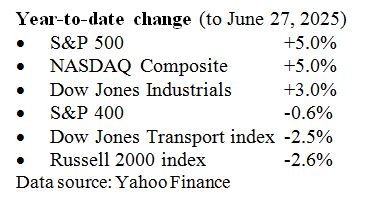by Bryan Perry
August 27, 2024
The latest astonishing downward revision of 818,000 jobs is the largest such downgrade in 15 years. That effectively means there were 818,000 fewer job gains than first announced from April 2023 through March 2024. That means 68,166 fewer jobs per month than the government reported. On Wall Street, this is called “painting the tape” – artificially manipulating data to create a better situation than actually exists.
So, instead of adding a robust average of 242,000 new jobs a month, which the Biden administration was so gleefully chirping about, the nation gained a more modest 174,000 jobs a month, according to the latest estimate. The largest downward revision was in professional and business services, with payrolls lowered by 358,000, followed by a 150,000 downgrade in leisure and hospitality and 115,000 in manufacturing.
Earlier this month, we learned that the non-farm payrolls for July was only 114,000, way below the consensus of 170,000, but this latest report calls into question what the real number was. In response to the August 2 report, the Dow dropped 1,000 points in a panic attack. Of course, some economists at Goldman and other firms are saying that the 818K downward revision is overstated because it doesn’t take into account the one million or so jobs that went to illegal immigrants. Great! Now the government is supposed to make adjustments for the underground (cash only) economies. That’s not reassuring at all.
Graphs are for illustrative and discussion purposes only. Please read important disclosures at the end of this commentary.
It is now clear that the outspoken critics of labor market statistics were right about the employment situation being not nearly as robust as the politicians said it was. Here’s the rub, the federal bureaucracy employment survey takes into account total jobs – whether full-time or part-time – not total job-holders, so recent statistics may reflect an economy where workers who have jobs are increasingly making ends meet by working two or more jobs. That is corroborated by the fact that the last time there was this kind of major downward revision was 2009 when the economy was dealing with the Great Recession. So much for the “blow-out” jobs report the mainstream media repeatedly touted throughout 2023 and early 2024.
Graphs are for illustrative and discussion purposes only. Please read important disclosures at the end of this commentary.
Now that the Fed has finally asserted itself to commit to lowering the Fed funds rate in its September 18 FOMC meeting, the bond futures market puts a 76% probability on a quarter-point cut that takes Fed funds to a range of 5.00%-5.25%. The next set of employment data will be released Friday, September 6th.
If Bidenomics is as successful as its proponents claim, how do they explain the rising level of businesses and individual bankruptcies, especially in 2024? Across all bankruptcy chapters, there is a consistent uptrend, including Chapter 7 filings—a lifeline for many struggling households—up 14% year-over-year.
According to a recent article at mortgagepoint, “Overall bankruptcy filings, including both commercial and individual cases, painted a grim picture of financial distress across the nation. Total bankruptcy filings reached 251,012 in the first half of 2024, marking a notable 15% surge from the 217,483 filings reported a year earlier. Individual filings mirrored this trend with a similar 15% increase, totaling 235,878 in the first six months of 2024 compared to 205,301 in the same period in 2023.”
Graphs are for illustrative and discussion purposes only. Please read important disclosures at the end of this commentary.
Bankruptcy Watch, which monitors bankruptcy data and statistics, wrote on August 19: “Looking ahead, the U.S. Department of Justice projects a substantial increase in bankruptcy filings. Its U.S. Trustee Program has estimated that bankruptcy filings will double over the next three years. This prediction, although bold, is corroborated by the broader economic data, including escalating corporate bankruptcies, tightening loan standards by banks, and the surge in delinquent debt balances and consumer debt.”
I’d say the data suggests there is more stress in the labor market, households and small businesses than is being reported, and the Fed will likely have to slash rates at a faster pace than what is currently projected.
The post 8-27-24: What the Massive Job Revisions Reveal appeared first on Navellier.






